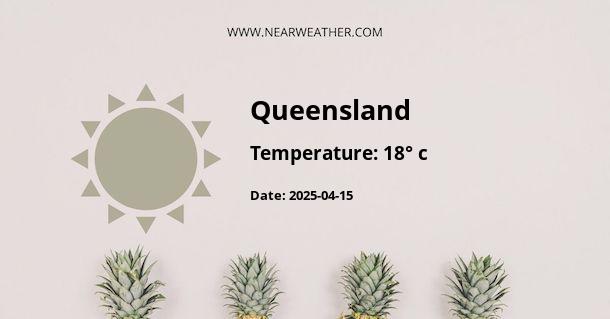Weather
18° 
Climate Conditions: clear sky
Humidity: 86%
Wind speed: 17.21 km/h
Wind direction: 113°
Daily Weather Forecast
Tuesday
04/15/2025
Climate Conditions: clear sky
Humidity: 85%
Wednesday
04/16/2025
Climate Conditions: clear sky
Humidity: 91%
Thursday
04/17/2025
Climate Conditions: broken clouds
Humidity: 64%
Friday
04/18/2025
Climate Conditions: broken clouds
Humidity: 78%
Saturday
04/19/2025
Climate Conditions: broken clouds
Humidity: 93%
Evolution
Daily Weather Forecast Evolution (°C)
Lowest temperature
Highest temperature
Other Information
Sunrise
06:30
Sunset
18:09
Latitude
-20.000000
Longitude
145.000000
Timezone: GMT+05:30
More about Queensland:
The Climate and Weather in Queensland, Australia
Queensland, located in northeastern Australia, is known for its stunning landscapes, vibrant cities, and diverse ecosystems. This state experiences a unique climate and weather pattern throughout the year, which contributes to its rich biodiversity and varied outdoor activities. In this article, we will explore the different regions of Queensland and delve into the climate and weather conditions that prevail in each area.1. Tropical North Queensland
Tropical North Queensland, encompassing popular destinations such as Cairns and the Great Barrier Reef, experiences a tropical climate characterized by two distinct seasons: the wet season and the dry season. The wet season in Tropical North Queensland typically begins in November and lasts until April. During this period, the region receives heavy rainfall, high humidity levels, and occasional tropical cyclones. The average monthly rainfall can reach up to 400mm (15.7 inches) in some areas, making it the wettest part of Queensland. The wet season is also accompanied by warm temperatures, with average highs ranging from 28°C to 32°C (82°F to 90°F). On the other hand, the dry season in Tropical North Queensland spans from May to October. This period is characterized by clear skies, lower humidity, and cooler temperatures. The average temperatures during the dry season range between 17°C and 26°C (63°F and 79°F), providing pleasant conditions for outdoor activities and exploration.2. Central Queensland
Central Queensland, which includes towns like Rockhampton and Gladstone, experiences a subtropical climate with distinct wet and dry seasons. During the summer months of December to February, Central Queensland receives most of its rainfall. The average monthly rainfall ranges between 75mm and 150mm (3 inches to 5.9 inches) during this period. The temperatures during summer can be hot, with average highs ranging from 30°C to 35°C (86°F to 95°F). In contrast, the winter months of June to August bring drier conditions to Central Queensland. The average temperatures during this period range between 10°C and 25°C (50°F and 77°F), providing milder and more enjoyable weather for outdoor activities.3. South East Queensland
South East Queensland, home to cities such as Brisbane, Gold Coast, and Sunshine Coast, experiences a subtropical climate with mild winters and warm, humid summers. During the summer months of December to February, South East Queensland experiences high humidity and occasional thunderstorms. The region receives an average monthly rainfall of around 100mm (3.9 inches) during this period, with temperatures ranging from 20°C to 30°C (68°F to 86°F). Winter months in South East Queensland, which span from June to August, bring cooler temperatures and less rainfall. The average temperatures during this period range between 10°C and 20°C (50°F and 68°F), providing pleasant weather for outdoor activities and exploring the region's natural beauty.4. Outback Queensland
Outback Queensland, covering vast areas of the state's interior, experiences a desert-like climate with hot, dry summers and mild winters. During the summer months of December to February, Outback Queensland experiences scorching temperatures, with average highs reaching 40°C (104°F) in some areas. The region receives minimal rainfall during this period, contributing to its arid landscape. In contrast, the winter months of June to August bring milder temperatures to Outback Queensland, with average highs ranging between 20°C and 25°C (68°F and 77°F). Despite the lower temperatures, it is still important to stay hydrated and protected from the sun when exploring the Outback.Conclusion
Queensland, Australia, offers a diverse range of climates and weather conditions across its various regions. From the tropical rainforests of Tropical North Queensland to the arid landscapes of Outback Queensland, each area presents unique opportunities and challenges for visitors. Whether you're seeking sun-soaked beaches, lush rainforests, or desert adventures, Queensland's climate and weather patterns provide a captivating backdrop for exploration throughout the year.References:
- Bureau of Meteorology - Australia: www.bom.gov.au - Tourism and Events Queensland: www.queensland.comFAQ's about Queensland's Weather:
Q - What is the Latitude and Longitude of Queensland?
A - Queensland's Latitude is -20.000000 & Longitude is 145.000000.
Q - What is the weather in Queensland today?
A - Weather in Queensland is 18° today.
Q - What is the climatic condition of Queensland today?
A - Climate Conditions in Queensland shows clear sky today.
Q - What is the humidity in Queensland today?
A - Humidity in Queensland is 86% today.
Q - What is the wind speed in Queensland today?
A - Wind speed in Queensland is 17.21 km/h, flowing at 113° wind direction. today.

Latest searched locations